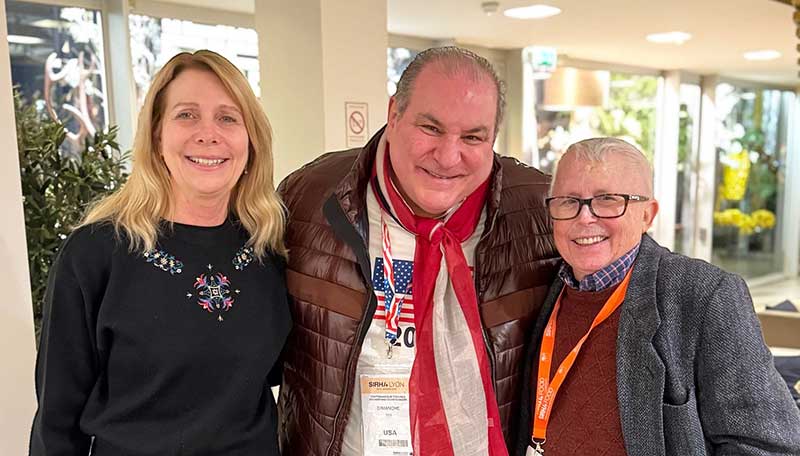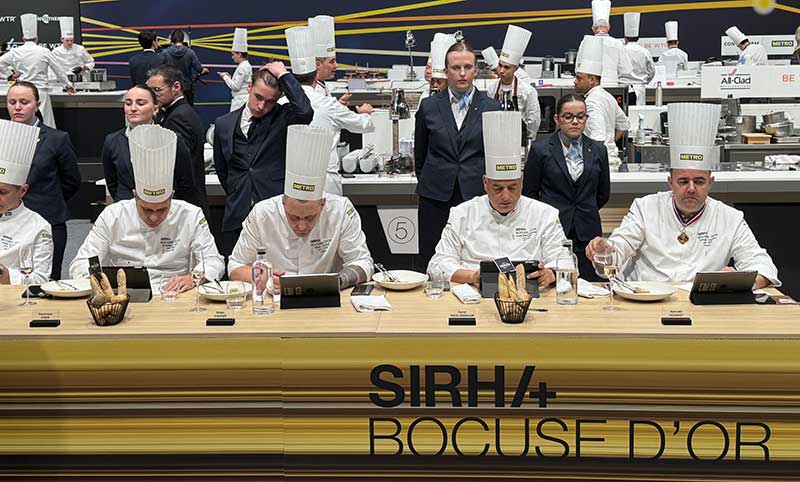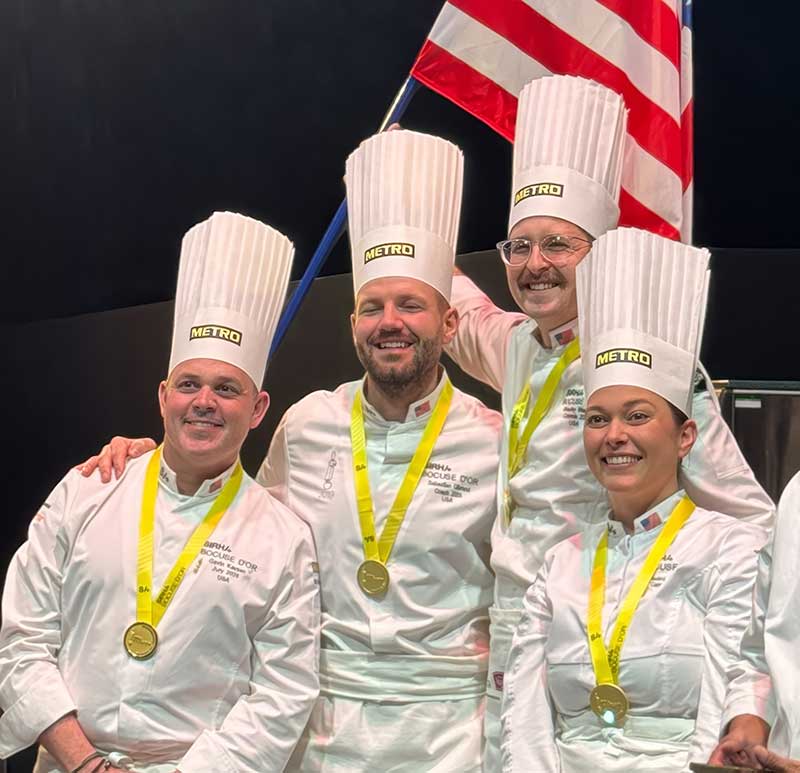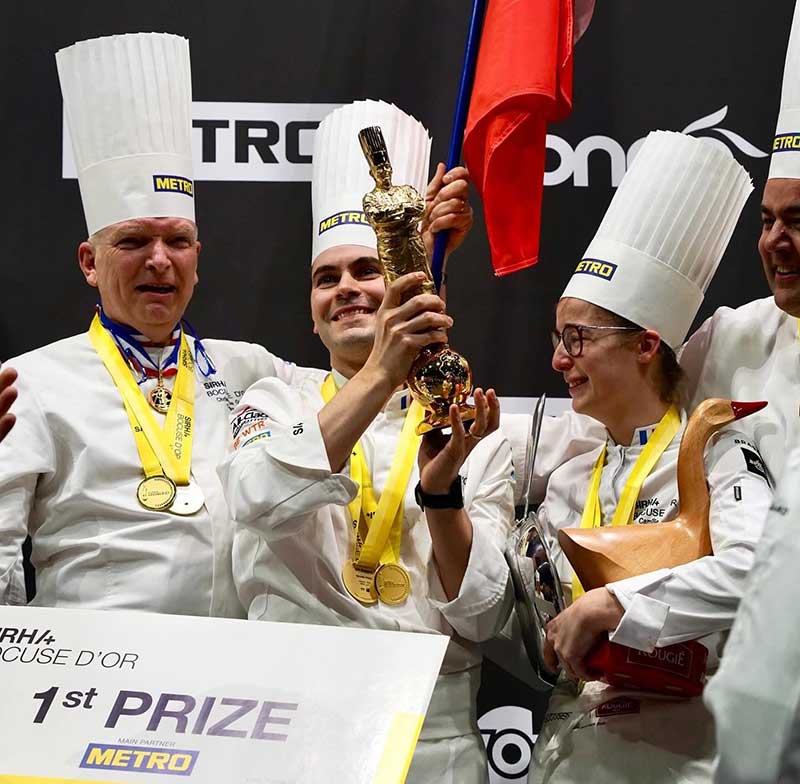
(L-R) Elaine Harris, Chef Paul Bartolotta, Scott Harris
The Road to Lyon Culminates in Bocuse d’Or
The Culinary Olympics
BY ELAINE AND SCOTT HARRIS
The Road to Lyon for Team USA began in New Orleans, widely considered one of the world’s top gastronomic epicenters. We witnessed Team USA compete against the best that the Americas had to offer, from Chile to Canada. After a tough battle, they won gold and qualified to compete against top chefs globally. We also had the privilege of spending time with David Leishman, Ph.D., who helped bring this competition to New Orleans. He is the U.S. Department of Agriculture (USDA) representative in France, serving as the senior advisor for food and agriculture at the U.S. Embassy. His insight proved beneficial in understanding the importance of this prestigious competition.
The Bocuse d’Or, founded in 1987 by Chef Paul Bocuse, is a prestigious culinary competition often referred to as the “Olympics of Cooking.” Held biennially in Lyon, France, the event celebrates culinary excellence and promotes the artistry of cooking.
“It is named after the celebrated French chef, Paul Bocuse (1926-2018), also known as ‘Monsieur Paul’ or ‘The Pope of Gastronomy,'” Dr. Leishman said.
Bocuse is widely esteemed as one of the foremost chefs of the 20th century. In 1982, he gained heightened fame in the United States after partnering with Walt Disney’s Epcot Center in Orlando, Florida. Eventually, he was the inspiration for the fictional character of Chef Auguste Gusteau in “Ratatouille,” a film presented by Walt Disney Pictures and produced by Pixar Animation Studios, which won an Oscar in 2008.
Bocuse excelled in all his culinary endeavors, striving to elevate the profession, celebrate excellence, and promote the artistry of cooking. He envisioned a platform where chefs could highlight their skills and creativity on a global stage, and thus, the Bocuse d’Or was born.
Before our journey to Lyon, we learned how this competition came to the United States. “I was serving as the director of the U.S. Agricultural Trade Office in Russia from 2015 to 2020,” Dr. Leishman said. “Chef Christian Têtedoie propelled my discussion with the organizers of the Bocuse d’Or. As president of the Maîtres Cuisiniers de France, Christian is one of the top chefs in France. We met years ago when I was in Russia, and he also happens to be one of the great star apprentices of Paul Bocuse. In 2023, at the Bocuse d’Or final in Lyon, we discussed bringing the competition to the United States.”

The Bocuse d’Or judging panel
Over the years, the competition has evolved into a prestigious event that attracts attention from culinary professionals, food enthusiasts and the media worldwide. It has become a benchmark for culinary excellence, inspiring chefs to pursue innovation and mastery in their craft.
Dr. Leishman noted, “In 1987, while serving as honorary president of the Culinary Sector Exhibition and Trade Fair in Lyon, Paul Bocuse launched the ‘Concours Mondial de la Cuisine,’ a truly international live cooking competition for young chefs selected to represent their country.” The competition is now known as the “Bocuse d’Or” or the “Golden Bocuse,” named after the gold statue awarded to the winning team.
Competing in the Bocuse d’Or is a rigorous two-day event. Each country is represented by a chef (the candidate) and an assistant chef (commis). Teams must prepare and present two main dishes, one focused on meat and the other on fish. Specific requirements vary, but they often involve whole cuts of beef and whole fish, showcasing chefs’ butchery and cooking techniques.
Timing in the kitchen is critical. Teams have a limited time, usually around five hours, to complete their dishes. This time pressure adds intense excitement and challenge to the competition, as chefs must manage their time effectively while ensuring the highest quality standards.
After finishing in the kitchen, chefs present their dishes in an aesthetically pleasing manner. The visual appeal of the dishes is significant, as judges assess not only the flavors but also the artistic presentation. Chefs are encouraged to incorporate culinary heritage and creativity elements into their plating.
The Bocuse d’Or judging panel comprises renowned chefs and culinary professionals from around the world. The esteemed panel evaluates the dishes based on specific criteria, including flavor profiles, how well ingredients complement each other, balance of flavors, seasoning and overall palatability.

(L-R) Team USA: President Gavin Kaysen, Head Coach Sebastian Gibrand, Commis Bradley Waddle, Head Chef Stefani De Palma
In addition, the ability to evoke emotions and create memorable flavor experiences is highly valued. Visual appeal is also critical in the judging process. Judges look for artistic plating, creativity in presentation and detailed composition. The presentation should reflect the theme and concept of the dish.
The execution of cooking techniques is closely scrutinized. Judges evaluate the precision in preparation, cooking methods, and overall craftsmanship. This combination of techniques in butchery, cooking and garnishing is essential for success.
Creativity and innovation are also important. Participants are encouraged to “think outside the box” and push culinary boundaries. Unique flavor combinations, modern cooking techniques and inventive presentations can set one dish apart from another. This balance between innovation and tradition is a hallmark of the competition.
The competition is fierce, with teams from over 60 countries participating. National selection processes, such as the Americas selection in New Orleans, ensure that only the best chefs reach the global stage.
Just as in the Olympic Games, fans travel to support their teams, waving flags, singing, and in Team USA’s case, ringing cowbells. Teams compete in identical kitchens with support from spectators. After the final dish evaluations, the chefs and supporters anxiously await the judges’ decisions. France won gold at the Bocuse d’Or 2025, Denmark took silver, and Sweden earned bronze. Team USA missed the podium this year but delivered impressive dishes in a tough competition. They won silver in 2015 and topped the podium in 2017 with gold.
Winning the Bocuse d’Or is a career-defining achievement that offers international recognition and opportunities.

Bocuse d’Or spectators from around the world cheer on their favorite teams
Past winners have gained fame, opened restaurants, and collaborated with top chefs. More than just a competition, the Bocuse d’Or celebrates culinary artistry, fosters innovation, and honors tradition, ensuring its lasting influence in the culinary world.
As Dr. Leishman put it, “Most importantly, the Bocuse d’Or encourages international camaraderie, emphasizing the Olympic spirit that ‘the important thing in life is not the triumph but the struggle; the essential thing is not to have conquered but to have fought well.'”
While in Lyon, we met two-time James Beard award-winning Chef Paul Bartolotta, who opened the renowned Bartolotta Ristorante di Mare at Wynn Las Vegas in 2005. We reminisced about the heyday of fine dining in Las Vegas and, of course, the Bocuse d’Or.
“I have been on the Ment’Or Culinary Council since 2015. The first Bocuse d’Or I participated in was in 2017, and I have traveled there every two years since. The Road to Lyon… Go Team USA!” he enthusiastically interjected. “2017 and 2019 were special years. In 2017, we took home silver with Chef Philip Tessier, and in 2019, gold with Chef Matt Peters. This year, I had high expectations. I remain convinced that Stefani De Palma was the right chef to represent Team USA, and that she will soon be one of the great chefs in America. I’m a huge fan!” he added with a smile.

Team France wins Gold: (L-R) Coach Christophe Quantin, Head Chef Paul Marcon, Commis Camille Pigot
Bartolotta emphasized that the Bocuse d’Or deserves greater recognition in the United States.
“First, it is a serious competition where chefs compete regionally to qualify for Lyon. For example, Stefani De Palma won gold in the America’s Cup in New Orleans last June. In other years, it was held in Mexico City or Santiago, Chile. Teams from North, Central, and South America compete, and only the gold, silver, and bronze winners earn the privilege of competing at the Bocuse d’Or in Lyon. A total of 24 countries vie for the coveted title.
“Second, we have a ‘farm team’ of young chefs and commis who compete regionally to represent Team USA or serve as support commis. Third, we raise funds for our scholarship and grant program, which helps young chefs attend top culinary schools or travel to apprentice at the world’s best restaurants—hence our name, Ment’Or! We mentor the next generation of American chefs.
“Lastly, we are working to amplify our voice in Washington and across the country to influence policies affecting our industry. Twenty-five years ago, America was emerging as a culinary powerhouse. Today, Team USA proudly represents our nation and culinary culture.”
It was an honor to attend the Americas selection and travel to Lyon for Bocuse d’Or 2025. After experiencing exceptional meals, impressive demonstrations from Michelin 3-star restaurants, exquisite wine, and a range of emotions, we are confident we will return in 2027.
See you in Lyon!



Leave A Comment